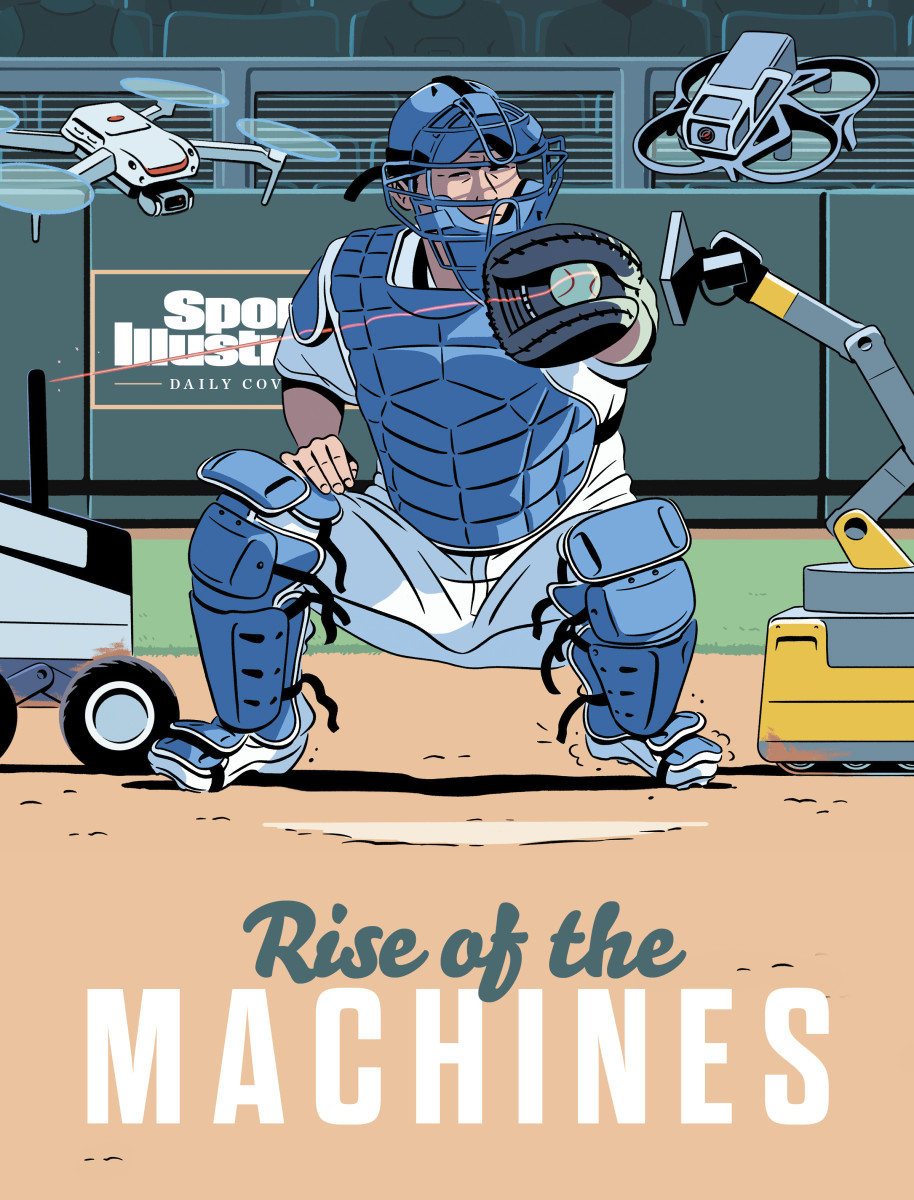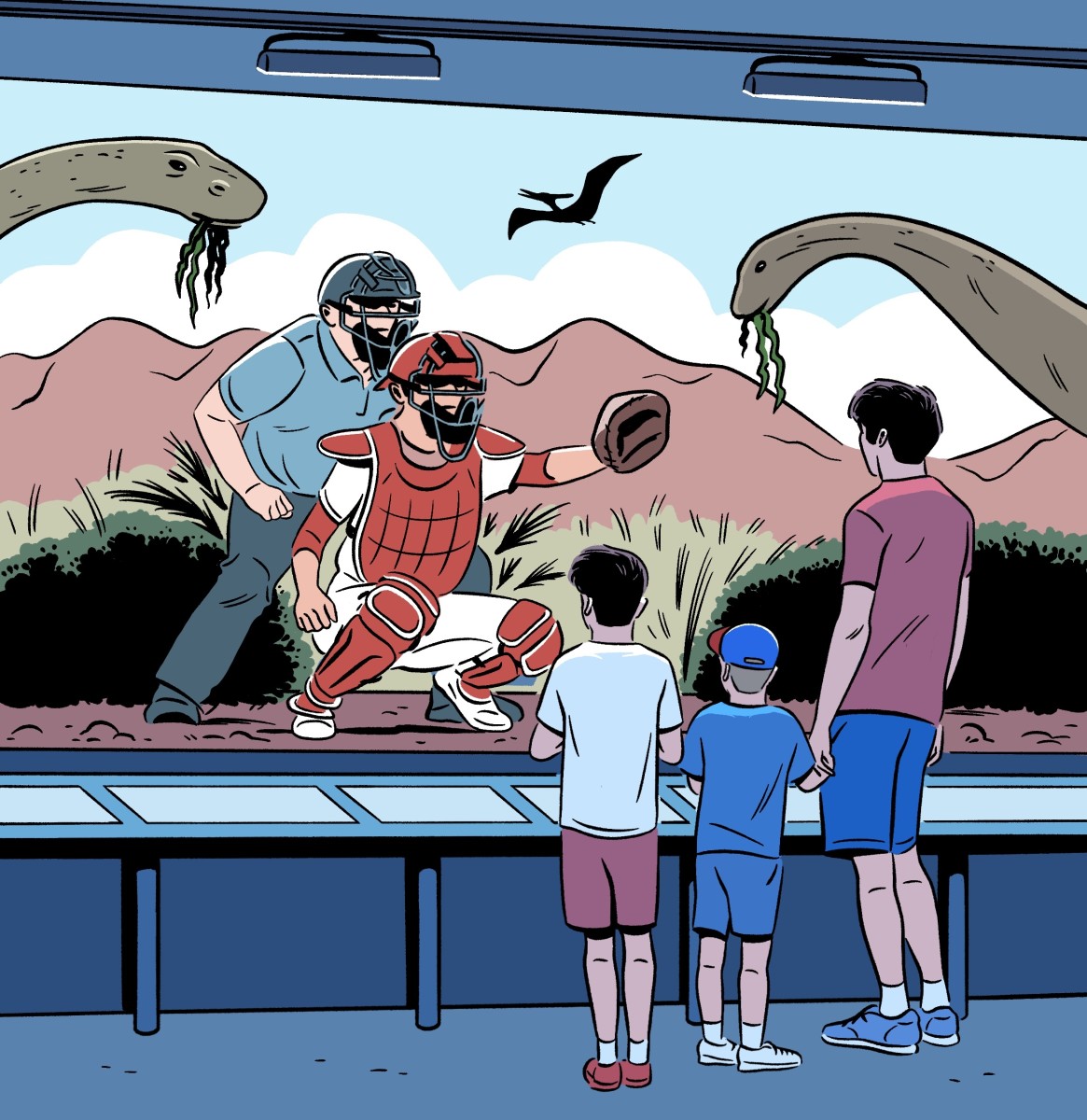Beware, Catchers: The Robots Are Coming

Charlie Greene tries to find something he can compare to what might soon happen to MLB catchers. He can’t.
The Brewers’ catching instructor reaches for a few analogies. This would be like telling a quarterback he can’t make passes of over 50 yards, he says. It would be like telling a basketball player he can’t dunk or take a three-pointer. But Greene knows these comparisons aren’t quite right. Those are physical acts, and he is talking about something artistic, philosophical, almost existential. As the veteran coach sees it, this is not about placing artificial limits on talent or making the position harder. It’s about taking away the heart of what it means to catch.

He is talking about an automated strike zone—a “robo ump.” After experimenting with the technology in independent ball and across the minor leagues, MLB will use an automated zone in all 30 Triple A parks in 2023, meaning its introduction to the majors will likely follow. Nothing is official yet. But the men who relay signs know one when they see one.
The system can determine balls and strikes with optical tracking data—a perfect, or at least perfectly consistent, zone. (One version in Triple A will be a full robo ump, determining every pitch, while the other will be a challenge system like that of professional tennis, where a human umpire calls the zone, but each team has three challenges per game for computer review.) Some people welcome the efficiency and fairness of an automated ball-strike system (ABS). Others bemoan the loss of the proverbial “human element.” But for catchers, the stakes are different: The robo ump might remove a significant piece of their skill set. Gone could be the need to “frame” a pitch—to receive it in a way that maximizes the chance of the umpire calling it a strike. At its most basic, this means keeping body movement smooth when catching anything on the edges of the zone. But many catchers see it akin to an art. And now it may be about to disappear.
Which stings all the more given the evolution of framing in the last decade.
Long considered a niche skill—emphasized heavily by some catchers and not at all by others—framing got a jolt from new technology. With the advent of pitch-tracking data in the late 2000s and early ’10s, front offices suddenly began to analyze framing as a measurable skill, and soon they quantified its effects. The art looked more like science. It didn’t take long for front offices, in their pursuit of an optimized version of baseball, to realize how valuable a piece of the puzzle pitch framing could be. After all, a catcher might have only a few balls to block during a game and even fewer runners to throw out on the base paths, but he would catch upward of a hundred pitches. Maybe just a handful that would otherwise be called balls could be framed as strikes. But they’d add up. That understanding led to a revolution. In a few years, pitch framing went from arcane skill to sabermetric hot topic to catching fundamental. It started as a way to gain a competitive edge on the margins. Then it became a necessity. Now? A relative of the technology that sparked its rise might kill it off.
In essence, pitch framing became valued when it could be measured, and the tools used to measure it might now be used to dismantle it. For catchers, it’s not just the end of an era. It’s the death of a craft.
“It’s that artistic side,” says retired catcher Jeff Mathis, a defensive specialist recognized as one of the best framers of the past two decades. “That’s out the window. Just catch it; put yourself in position to block or possibly throw, and let the robots take over.”

Catchers know you may not feel sorry for them. Pitch framing is why baseball needs ABS in the first place, you might say. But they see it differently. They don’t talk about their job as manipulating the ump or luring him into obviously incorrect calls. (Which they couldn’t do, anyway: Even a framer like Mathis could never make a ball that far outside a strike.) Instead they see it as a quest to make their pitchers look as good as possible, doing their best to ensure they don’t lose any obvious strikes.
“I don’t think you’re trying to fool the umpire,” says Tigers director of coaching Ryan Sienko, a former catcher whose current job is focused on the position. “What you’re trying to do is keep the ball in the strike zone as much as you can.”
Or, per the reigning framing king: “I’m not worried about the umpire,” says Yankees catcher Jose Trevino, who led MLB in most framing stats in 2022. “I’m worried about my pitcher.”
There have been catchers taking pride in framing as long as the position has existed. But it was traditionally hard to notice and harder to measure. It didn’t show up in a box score or highlight reel. It was, in a sense, the ultimate representation of human interaction in baseball. Yes, it was about the imperfect judgment of the umpire, but it was also about the connection between pitcher and catcher. It was about trust.
“It’s something you have to have a lot of pride in,” Mathis says. “You’re catching 150 pitches a night, you know, maybe closer to 175. It’s easy to take four or five pitches off. But those four or five pitches that you take off might not get called strikes. You might botch one, you might have that pitcher look at you as you catch it, you might deflate his confidence.”
Naturally some catchers had always prioritized framing. But there was no consistent language—“framing,” “presentation,” variations on “receiving”—let alone consistent instruction. There were certainly no statistics.
Then came pitch-tracking data.
One of the first people to use PITCHf/x to study framing was a baseball fan and hobbyist researcher named Dan Turkenkopf. He’d figured that framing might be statistically important. But even he was surprised when he tried to quantify it. His first analysis, published on the blog “Beyond the Box Score” in 2008, found the difference between the best framer (Gregg Zaun) and worst (Gerald Laird) had been equal to 25 wins in ’07.
The numbers were soon refined. But Turkenkopf’s framework held true: Pitch framing could have a massive impact. And since clubs had not paid much attention to it—let alone tried to cultivate it—the gap between good and bad was huge. Quickly, front offices took note. (They also took the bloggers publishing this work: Turkenkopf is now the Brewers’ vice president of baseball research and innovation.) Smart teams recognized a small investment in research could pay dividends on the field.
“It was a pretty quick diffusion through the league to start really making changes, once teams kind of got on board with this being a measurable skill,” Turkenkopf says.
At first, front offices focused on identifying the best framers in the game and picking them up before others understood their value. Then savvy teams started thinking bigger: They didn’t want just to find the best framers but to develop more of them. What had once been an opaque art was becoming a cold, hard darling of the analytic set.
“You were still gaining at the margins a lot,” says Sienko. “Whether it be by just drills or techniques or learning how to understand what the numbers were.”
An industry of coaches and consultants popped up. Strategies became more sophisticated. Trevino laughs now at film from 2016 or ’17, when the style was a catch-and-stick method that now looks unnatural. “Those videos,” he says, “I’m trying to hold the ball as still as I could, but I’m trying to move it up towards the strike zone.” The numbers got more specific, and the coaching more advanced. And soon the landscape evened out. The game’s strongest framers had more competition. The weakest had disappeared. If pitch framing had once been a market inefficiency for teams to exploit—well, here was efficiency.
“When I first started, there was a drastic difference between the best and the worst,” Greene says. “Now, the gap is maybe only a couple wins. . . . Everyone’s caught on.”
All this happened within the space of a playing career. In 2005, pitch framing had been intangible. By ’10, it was measurable, which in turn made it valuable. This meant that in ’15, it was inescapable, and in ’20, it was fundamental to the position. It had been observed, quantified, refined and, finally, almost, taken for granted.
“It took over the position,” says Tigers manager A.J. Hinch, a former catcher himself. “It got to a place where that’s the first thing you look at when evaluating a catcher.”

Framing is not dead yet. Executives around the league stress this: While catchers and their coaches nervously anticipate a funeral, pitch framing still means something in the major leagues, and teams will recognize it until it doesn’t.
“We’re experimenting with different ways as an industry to think about calling balls and strikes,” says Red Sox chief baseball officer Chaim Bloom. “But we don’t know yet which direction that’s going to go.”
The technology has been refined since ABS was first tested in the Atlantic League in 2019. The Triple A tests this season will be split: During the week, a robo ump will determine every pitch, but weekends will have a challenge system. “Number one, in terms of what we hope to learn, is to get a firmer read on player preferences between the two systems,” MLB commissioner Rob Manfred said in February. “We do not have a fixed idea or timetable on ABS.” He said Triple A was chosen this year specifically to get as close as possible to a major league environment.
The challenge system is pitch framing’s last hope. “If there’s no challenge system, framing just goes away,” Royals executive vice president of baseball operations and general manager J.J. Picollo says. “But if there’s a challenge system, your catching profile’s going to be the same.” For anyone wary of an automated zone, the challenge system can feel like a good compromise, generally preserving human judgment while turning to the computer for the most consequential situations. But there’s a big gap between that and exclusively automated balls and strikes.
“I’m not excited about the idea of total ABS. . . . I’m a little guarded about what that’s going to bring,” says Orioles executive vice president and general manager Mike Elias. “I worry about unintended effects towards the catching position.”
Such as?
“If you remove one huge component from the defensive skill set, just totally take it away, that the other parts of the pie chart of what it means to be a good catcher are going to fill it in,” he says. “And I don’t know how the filling in is going to happen, exactly. It may not be something that we like.”
That could mean more focus on how a catcher handles the running game (especially with new rules to revive the stolen base: larger bags and limited pickoff moves). It could mean the position becomes less about defense and more about offense. It could mean something else. “It offers new challenges,” Sienko says. But it almost certainly means the position will look different.
“It’s not going to be as pretty,” Mathis says. “Because guys won’t have to worry about where they’re catching—just keep it in front of you, and it’s called ball or strike, and then we move on to the next pitch.”
There is, of course, a natural rebuttal to this: That’s how it should be. For those in favor of an automated zone, the whole point is calling ball or strike and then moving on to the next pitch, no frustrations or tricks. There are objective truths here. And yet . . .
“Most of the umpires are very good at this,” Greene says. “Maybe you miss a couple. But I think the human element is all part of it. There’s a human element in every sport.”
The term human element is one that comes up often in these conversations. In some cases, it’s simply a euphemism for the ability to be wrong. But in others, it’s something else, a catch-all term for art and uncertainty and emotion. It’s either incidental to baseball or it’s the whole point.
“It’s the human interaction and human element of the game. That’s fun,” Hinch says. “So we’ll give it a chance, and the game will probably be more accurate, and it’ll be better for it. But there’s a part of the purity of the game that we were raised on that will change.”
This is where an automated strike zone differs from using replay review to verify a home run or a tag play. The home plate umpire has a role unique not just in baseball but in professional sports: He does not offer his judgment on specific moments or in extreme cases but on every last pitch. His choices—literally—shape the game. Which is reason either to remove that responsibility entirely or to recognize it as an essential part of the game.
It took all of two days for the first ejection after the Atlantic League adopted its original automated zone in 2019. The honor belonged to High Point Rockers
pitching coach (and 1988 Cy Young winner) Frank Viola. “Do your f---ing job!” he yelled at the umpire when frustrated with the zone from the computer. So the ump did part of the job he had left: He tossed Viola. Then he returned to signaling the balls and strikes being called by the computer above. There was confusion, Viola later said; he had been unsure who (or what) was in charge. But the implication lingered: Isn’t this your job?
“It’s the human element of the game, the balls and strikes from the umpire,” Trevino says. “You take that out, and it’s just like, O.K., what are we really doing?”
Trevino had 5,525 framing chances in 2022. His favorite? In early September the Yankees were playing the Rays, and Tampa Bay third baseman Yandy Díaz stepped into the box against New York reliever Clay Holmes. Two outs. Bottom of the ninth. A potential tying run at third and winning run at second. The tension of the moment stretched until the count was full.
And here was the 3–2 pitch: a 102-mph sinker that sank a touch more than Holmes wanted. Díaz knew it. He didn’t swing. But Trevino knew it, too. And he received the pitch with an easy confidence befitting a strike. His gracefulness made the movement hard to spot, even on replay. All the video shows is that one second, the pitch is coming in low, and the next, Trevino has secured it inside the zone.
This was strike three.
“You put so much work in on the receiving end for that one moment, right there, that time and place,” Trevino says. “All of a sudden, everything just kind of is full circle. The ball is down—you worked on this move for however many years—strike three.”
It was a perfect example of the desire for an automated zone. That was a ball. It was low, and Díaz knew, and he struck out nonetheless. The call was wrong. Had it been right, Tampa Bay might have won the game, and who knows how much else. It was a straightforward case of wrong and right where human judgment erred in a way a computer never would.
Yet it was also a perfect example of why there’s resistance to an automated zone. There’s the elegant, slight motion of Trevino’s glove as he converts ball to strike, the product of countless hours of dedication to his craft. There’s the fierce emotion of the whole moment. Umpire Vic Carapazza delivered the strike call with gusto—a splashy, dramatic punchout—as if to assert his confidence in it. Díaz threw down his helmet and twisted his shoulders in frustration. The whole moment thrummed with passion.
Carapazza believed what he saw; Díaz believed what he saw; Trevino did not have to believe his eyes because he believed in his hands. There was something to feel in part because there was something to argue over. It felt like art in more ways than one.
MLB shared this highlight on its website as “Clay Holmes seals 2–1 victory.” Trevino would never take issue with that description—his job is to make his pitcher look his best, after all, and that’s what he did—but he knows the truth. Holmes set up the victory. Trevino sealed it.
He made it art. He made the pitch a piece you wanted to look at—and then, just as crucially, he made you question what you saw. He framed it.
